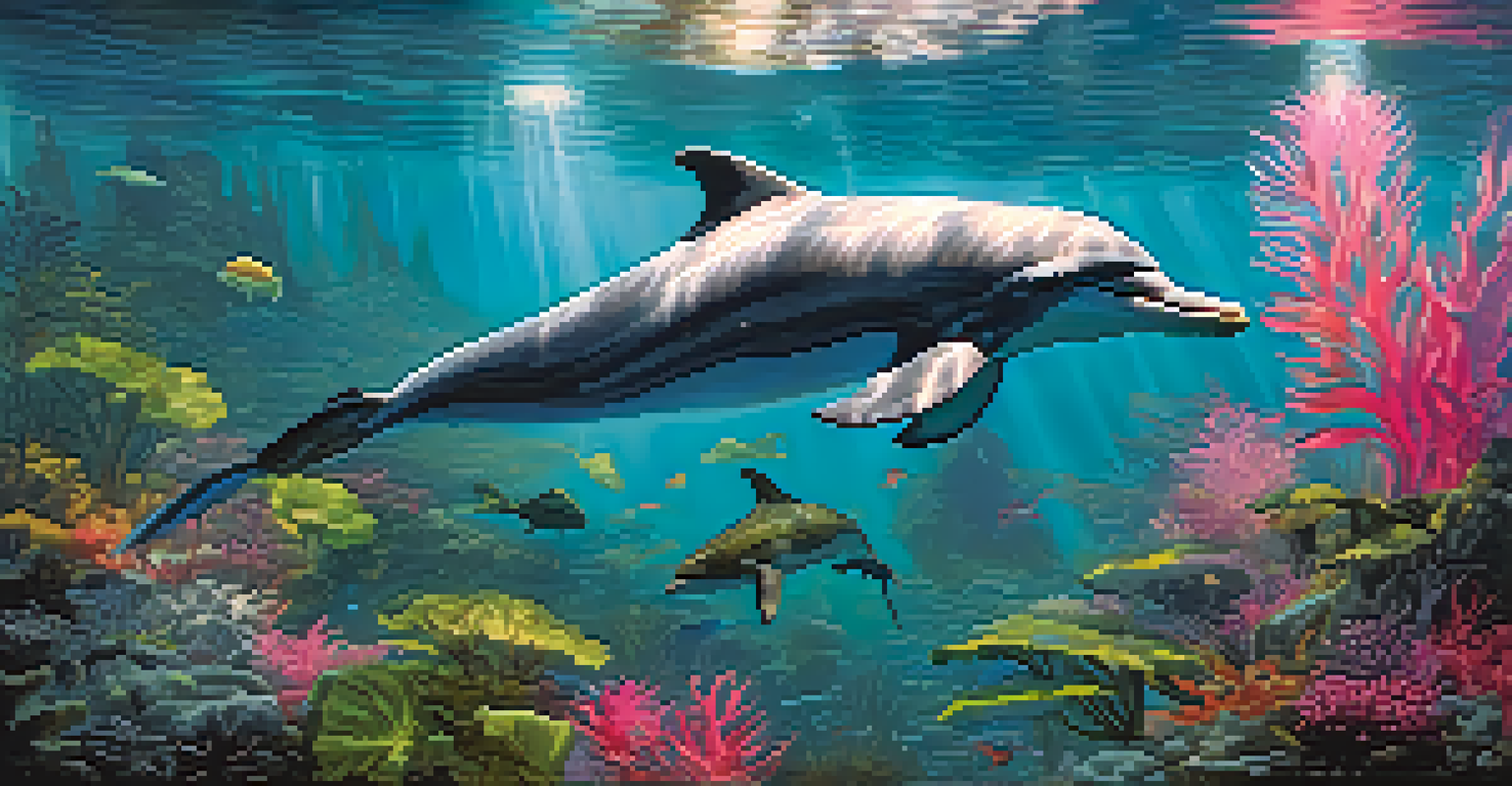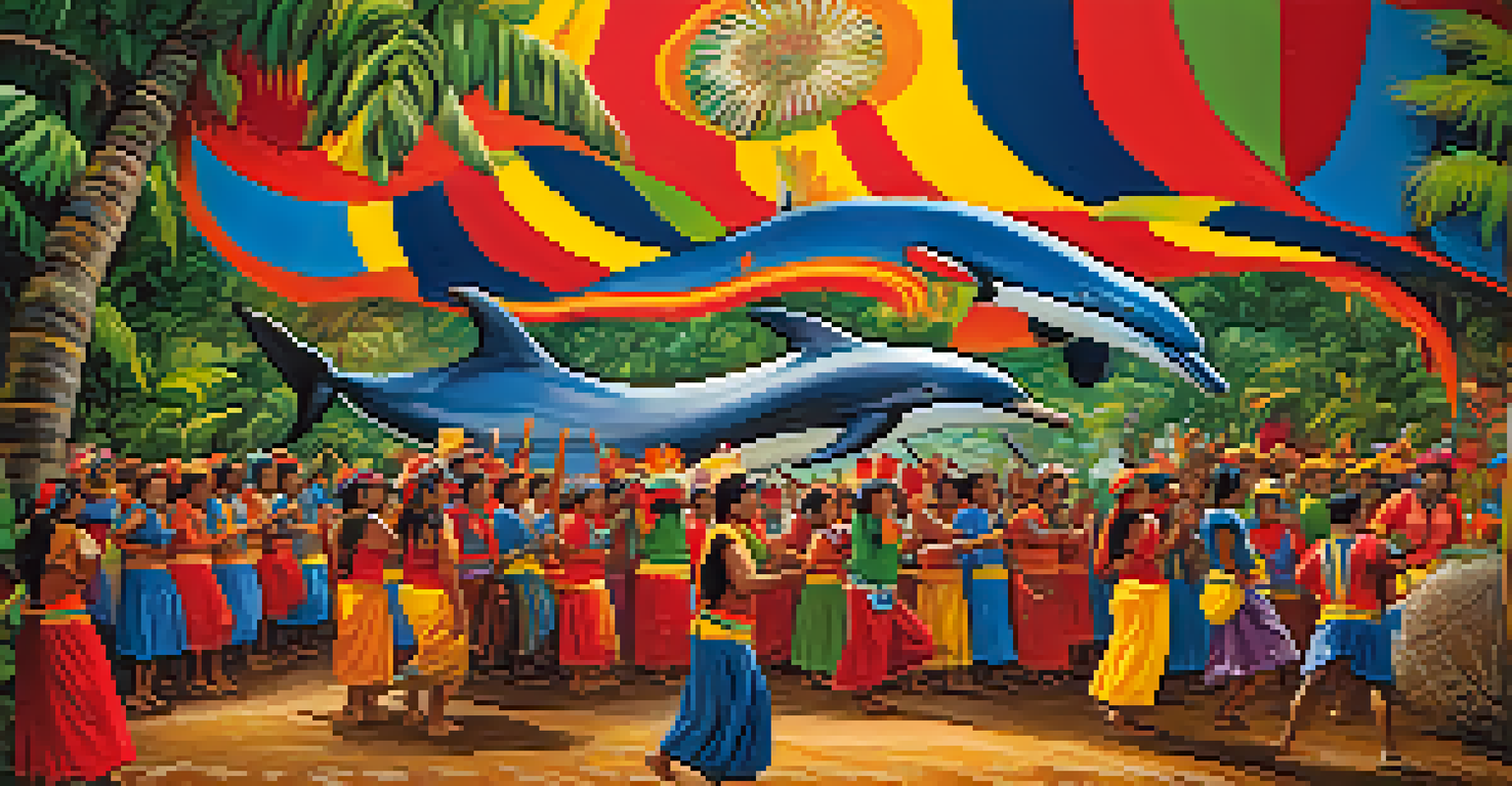Unveiling the Legend of the Boto: Amazon's Enigmatic River Dolphin

Introduction to the Boto: Myths and Mystique
The Boto, or Amazon river dolphin, is not just a creature of the river; it's a symbol of mystery and folklore in the Amazon region. Local legends often speak of these dolphins transforming into handsome men to lure unsuspecting women. This enchanting narrative adds an air of intrigue to the Boto, making it more than just a marine mammal—it’s a part of cultural identity.
The Amazon rainforest is a world of wonders, holding secrets of nature that we have yet to fully understand.
In many Amazonian communities, the Boto is revered, and stories about its magical abilities are passed down through generations. These tales often revolve around love and caution, showcasing how the Boto bridges the gap between nature and human experience. Such myths help to illustrate the deep connection between the people and their environment, making the Boto a true legend.
Beyond the myths, the Boto is a fascinating animal with unique characteristics. Known for its pink hue and playful nature, the dolphin navigates the intricate waterways of the Amazon with ease. This blend of myth and reality keeps the Boto at the heart of both ecological and cultural discussions.
The Habitat of the Boto: Amazon's Aquatic Wonderland
The Amazon River basin is the Boto's natural habitat, rich in biodiversity and teeming with life. Spanning multiple countries and encompassing thousands of waterways, this environment is crucial for the Boto's survival. The complex river system provides both food and shelter, creating a perfect ecosystem for these dolphins.

Unlike their oceanic relatives, Botos thrive in freshwater, often found in murky waters filled with vegetation. This habitat allows them to hunt for fish and navigate through submerged forests. The rivers' ever-changing nature, influenced by seasonal floods, creates a dynamic living space that the Boto is uniquely adapted to exploit.
Boto: Myth and Cultural Identity
The Boto, or Amazon river dolphin, is deeply woven into local folklore, symbolizing love and mystery while showcasing the cultural connection between communities and their environment.
As the Amazon faces environmental threats, understanding the Boto's habitat becomes increasingly important. Preserving this intricate ecosystem is vital not only for the Boto but for countless other species that call the Amazon home. This interconnectedness highlights the importance of conservation efforts in maintaining the delicate balance of life in the Amazon.
Physical Characteristics of the Boto: Nature's Wonder
The Boto is renowned for its distinct appearance, featuring a blend of gray and pink hues that can vary with age and mood. Unlike sea dolphins that have streamlined bodies, the Boto’s shape is more robust, allowing it to navigate through dense river vegetation. This unique morphology makes the Boto a fascinating subject of study in marine biology.
The greatest threat to our planet is the belief that someone else will save it.
One of the most interesting features of the Boto is its flexible neck, allowing it to turn its head in various directions. This adaptation is essential for hunting in the cluttered waters of the Amazon. Coupled with their echolocation abilities, Botos are skilled hunters, often preying on fish, crustaceans, and even small turtles.
Additionally, Botos possess a layer of blubber that helps them maintain body temperature in varying water conditions. Their large, rounded fins not only aid in swimming but also provide stability in the ever-shifting currents of the river. These physical traits showcase the Boto's incredible adaptation to its environment.
The Boto's Diet: Fish and Foraging
The diet of the Boto is as diverse as the Amazon itself, primarily consisting of fish, which they catch using their echolocation skills. These dolphins are known to hunt in various ways, often foraging in shallow waters or diving deep to catch their prey. This flexibility in hunting methods allows them to thrive in an environment where food sources can fluctuate.
One of the Boto's favorite meals includes the piranha, a fish that many fear yet the Boto tackles with ease. They also consume catfish and other local species, showcasing their role as a significant predator in the river ecosystem. This predatory behavior helps maintain the balance of aquatic life in the Amazon.
Threats to Boto's Survival
The Boto faces significant threats from habitat destruction, pollution, and human activities, which jeopardize its population and the delicate Amazon ecosystem.
Interestingly, Botos are also known to exhibit playful behaviors while hunting, sometimes tossing their catch into the air before eating it. This playful nature enhances their charm and keeps them in the hearts of those who observe them. Understanding their diet helps shed light on the health of the Amazon's ecosystem and the importance of preserving it.
Cultural Significance: The Boto in Folklore
In Amazonian culture, the Boto holds a special place in folklore and storytelling, often symbolizing love and transformation. Tales of the Boto transforming into a handsome man to seduce women reflect deep-seated beliefs about nature and spirituality. Such stories serve to educate younger generations about respect for the river and its inhabitants.
These legends often carry moral lessons, warning of the consequences of vanity and deception. The Boto’s dual nature—as both a charming figure and a powerful creature—captures the complexities of human relationships with nature. This storytelling tradition fosters a sense of community and connection to the environment.
Moreover, the Boto is often featured in local art, music, and festivals, reinforcing its status as a cultural icon. These expressions of creativity not only celebrate the Boto but also raise awareness about its conservation status. Embracing the Boto's cultural significance can inspire collective action to protect its habitat.
Threats to the Boto: Conservation Concerns
Despite its mythical status, the Boto faces numerous threats that jeopardize its survival. Habitat destruction due to deforestation, dam construction, and pollution poses significant risks to these dolphins. The alteration of river systems disrupts their feeding and breeding grounds, leading to a decline in their population.
Additionally, accidental entanglement in fishing nets and illegal hunting further exacerbates their plight. As human activities continue to encroach upon their natural habitat, the Boto's future hangs in the balance. Understanding these threats is crucial for developing effective conservation strategies.
Conservation Efforts in Action
Various organizations are actively working to protect the Boto and its habitat through community engagement, education, and the establishment of protected areas.
Fortunately, various organizations are working tirelessly to protect the Boto and its environment. Raising awareness about the importance of preserving the Amazon's ecosystems can foster community support for conservation efforts. By highlighting the Boto's plight, we can inspire a collective commitment to ensuring its survival for generations to come.
Conservation Efforts: Protecting the Boto and Its Habitat
Efforts to conserve the Boto and its habitat are gaining traction, thanks to the dedication of various environmental organizations. Initiatives focus on protecting the Amazon rainforest and maintaining clean waterways, which are essential for the Boto’s survival. These strategies often involve collaboration with local communities to promote sustainable practices that benefit both people and wildlife.
Education plays a critical role in these conservation efforts, helping communities understand the importance of preserving the Boto. Workshops and outreach programs aim to teach sustainable fishing techniques and the ecological importance of the Amazon's biodiversity. This grassroots approach fosters a sense of ownership and responsibility toward the river ecosystem.

Additionally, some conservation groups are working on creating protected areas in the Amazon to safeguard the Boto's habitat. These sanctuaries not only provide a safe haven for the dolphins but also help maintain the rich biodiversity of the region. By investing in conservation efforts, we can ensure that the legend of the Boto continues to thrive in the heart of the Amazon.